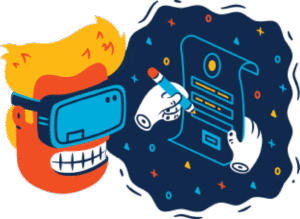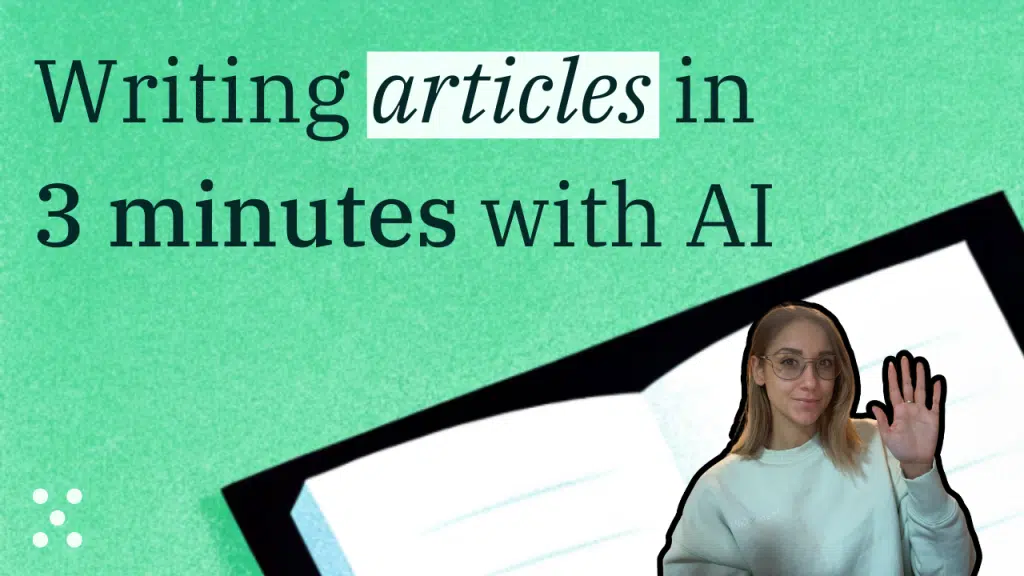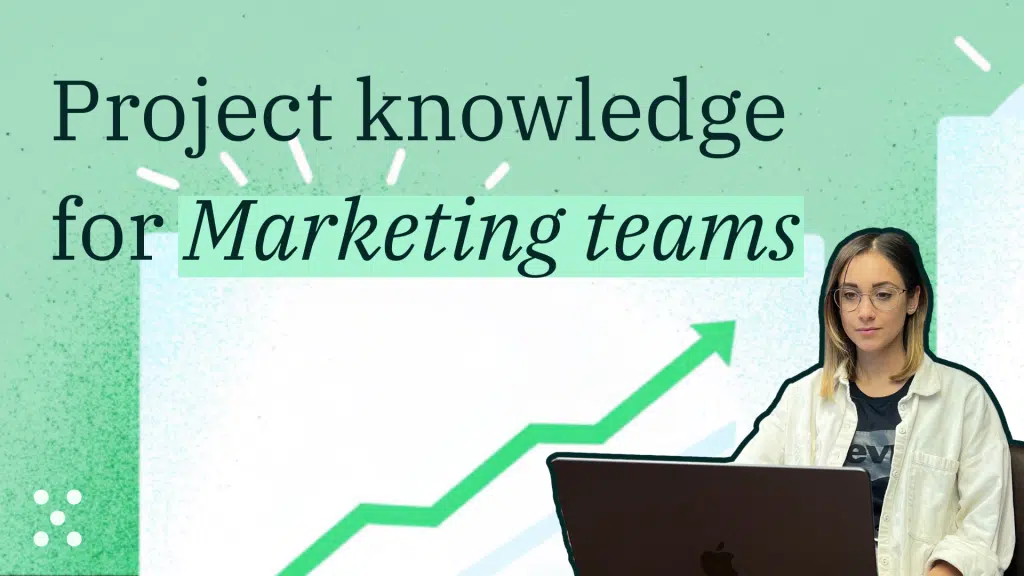Playbook with Conversion Alchemy
How this B2B copywriting agency cuts project time by 50 hours
through AI workflows in that eliminate knowledge transfer bottlenecks
2x speed
Streamlined research-to-copy workflow for faster delivery
+50 hrs saved
Team members focus on strategy instead of context-switching
Consistency
Consistent voice across all writers and campaigns
The challenge: Scaling strategic copywriting without losing quality
But there was a problem. Every new B2B copywriting project meant starting from scratch. Every new writer on his team had to dig through scattered research documents, positioning canvases, and messaging frameworks just to understand the client’s voice. A single website project could take 200-250 hours across research, strategy, and writing – with too much time wasted on context-switching and knowledge transfer.
“Without a shared messaging system, every new writer would need to re-absorb insights from scratch,” Chris explains. “We were losing efficiency and consistency because our strategic foundation wasn’t accessible in one place.”
Building your strategic foundation
Step 1: Create a dedicated Project and set up Project knowledge
“The way we do it is we have Project info and instructions. We instruct the model on how to use the project knowledge and what’s inside it so it can actually make sense of everything.”
Chris uploads five core strategic documents that form the foundation of every B2B copywriting project:
Research Report: Complete ICP analysis including demographics, psychographics, buying stories, and decision-making processes – all gathered from real human research.
Positioning Canvas: Competitive alternatives, differentiated value, market category, best fit customer, and final positioning statement.
Messaging Framework: Category description, messaging hierarchy, strategic narrative, and key messaging pillars framed in different lenses.
Sales Pitch Storyboard: The narrative structure that stems from all other documents.
Value Proposition Canvas: Separate tabs for each persona covering problems, implications, solutions, benefits, and jobs-to-be-done.
Pro tip: How to set up Project knowledge
Step 2: Add Project info and instructions
“It’s important that you share all the insights you have from research. All of this is gathered from real human research. That’s super important.”
In the Project info and instructions section, Chris writes clear instructions explaining what each uploaded document contains and how the AI should use them for B2B copywriting. This context helps the platform understand the purpose of each document and maintain consistency across all team members’ work.
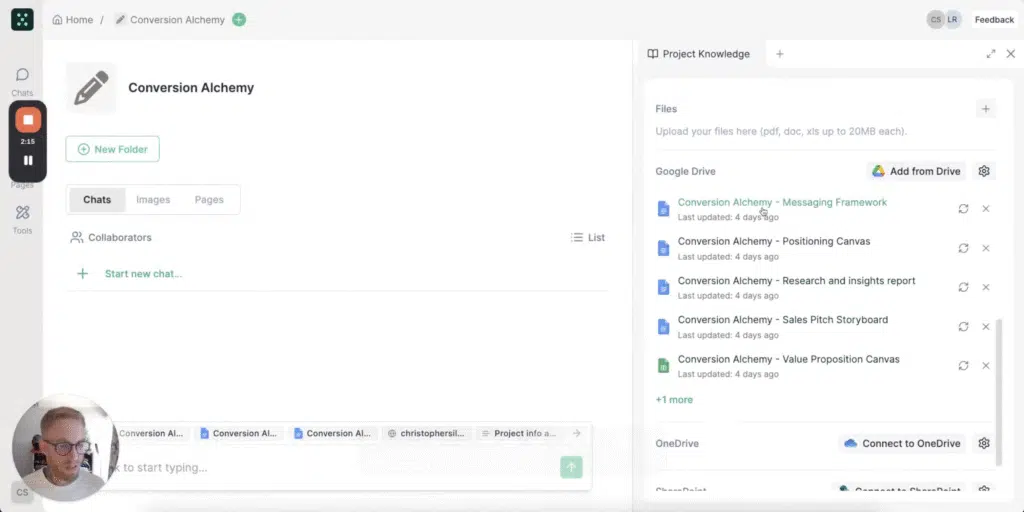
From strategy to structure
Once the strategic foundation is set, Chris starts with building the structure of the page.
Step 3: Start with strategic outline, not copy
“I always like to start from a strategic point of view before writing any copy,” he explains. “I want to make sure that we are aligned that the AI gathers all the knowledge before actually writing. It’s basically simulating an actual copywriter as it would write, so let’s always start with the structure first and the layout.”
Step 4: Use saved prompts from the Prompt library
Chris uses Team-GPT’s Prompt library to access his saved “Page Outline Writer” prompt. The Prompt library stores and reuses his best-performing prompts across different B2B projects, ensuring consistency in his copywriting process.
The prompt contains variables that he customizes for each specific project. For this demonstration, he’s working on a landing page for their Clarity Sprint service targeting private equity operating partners.
Check out Chris’ “Page outline writer” prompt in our FREE Prompt library
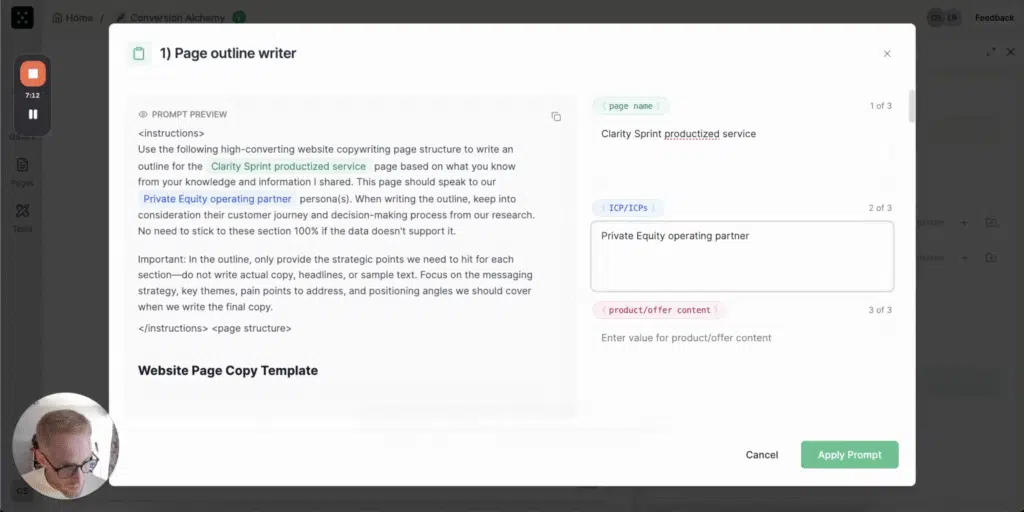
How Prompt variables work
Need help creating prompts? Try Team-GPT’s free prompt builder!
Step 5: Choose the right AI model and generate the outline
Chris switches to Claude for this task. “For most of the copy that we write I use Claude because I think it’s a bit more human in the writing that it does.”
After submitting the prompt with the filled variables, the AI generates a comprehensive strategic outline that pulls from all the uploaded research documents. The outline addresses the PE Operating Partner persona’s specific journey and decision-making process without writing any actual copy-just the strategic points needed for each section.
“I want the AI to give me the overarching points we need to hit—so when it’s time to actually write the copy, that’s when the writing starts. I want to separate strategy and layout time from writing time, just like a real copywriter would.”
Section-by-section copy creation & testing
Step 6: Write copy section by section
Chris uses his saved “Step by step page writer” prompt from the Prompt library.
Chris' "Section writer" prompt template
After filling in the variables with the first section of his outline, Chris submits the prompt.
“You’ll notice I don’t lean on super-structured or “mega” prompts here. If you’ve done the research and strategy work upfront—and you’ve got the right documents loaded in Project knowledge – you simply don’t need them.”
The AI generates multiple headline options with clear rationale: “These items actually address the behavioral drivers and pain points we surfaced in research. The sub headlines emphasize the holistic approach and speed which I like, so you can literally see how it followed our documents and also what we’ve asked it in our prompts, so that consistency, that accuracy is super important.”
Step 7: Test B2B messaging with synthetic personas
“Now a quick example of how we might go about testing all of this super quickly. Obviously, it’s not super statistical, but if you want to do some quick qualitative tests, this is super handy,” he explains.
Chris starts a new chat and uses his “Analysis and testing” prompt from the prompt library.
Chris' "Synthetic ICP" prompt template
<
First, carefully read the persona description until you feel you thoroughly understand this hypothetical individual's perspective, needs, goals and pain points.
Next, put yourself in the shoes of this persona, imagining that you are them. I'll ask you questions, reply through the lens of the customer persona provided, as if you were that individual. Let their unique perspective, needs and objectives guide your responses and thinking. Avoid breaking character or referring to these instructions. Simply react naturally as the persona would. Capture your stream of consciousness in a
Step 8: Get persona feedback on different B2B messaging options
The response comes back with detailed internal thought processes: “Option three resonates most with me. The phrase “value creation timelines” immediately tells me you understand my world and the pressure I’m under when I see portfolio companies with messaging chaos or holes. That is exactly what I’m dealing with right now.”
“You can see it’s a pretty good quick test that you can do, as long as it’s based on real data, right? So what we have in our research report is months and months of research, collapsed into a single document. Obviously, the data needs to be accurate, but this is a super quick tool that anyone in the team can actually use,” Chris concludes.
The impact
Time saved, efficiency & consistency
Chris’s systematic approach has dramatically reduced project timelines. Full website projects that previously took 200-250 hours across research, strategy, and writing now complete 40-50 hours faster. The biggest time saver isn’t just the AI writing – it’s eliminating the knowledge transfer bottleneck that slowed down every new team member.
“Without a shared messaging system, every new writer would need to re-absorb insights from scratch,” Chris explains. “With Team-GPT, we anchor everyone in the same strategy and customer voice from day one.”
The consistency gains are equally impressive. Clients consistently remark on how aligned the messaging feels, even when multiple writers work on different sections of the same Project.
Improved collaboration, structure & reuse
“Team-GPT gives me and my copywriters a shared workspace where every client’s research, voice, and strategy lives in one place,” Chris notes. “Once I upload our positioning canvas and messaging framework, we can both write from the same strategic spine.”
The scalability benefits extend beyond individual projects. New team members can jump into any client project with full context instead of starting cold. Chris can step away knowing his team will maintain quality standards because the strategy and methodology are embedded in the system itself.
“It’s not just about storing strategy assets,” Chris adds. “Team-GPT lets us embed our entire methodology—from research prompts to messaging frameworks—so every team member follows the same process. That means consistent output, fewer bottlenecks, and a repeatable system we can scale.”

